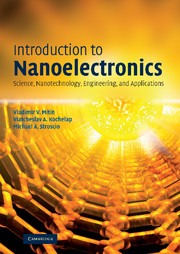Book contents
- Frontmatter
- Contents
- Preface
- List of notation
- 1 Toward the nanoscale
- 2 Particles and waves
- 3 Wave mechanics
- 4 Materials for nanoelectronics
- 5 Growth, fabrication, and measurement techniques for nanostructures
- 6 Electron transport in semiconductors and nanostructures
- 7 Electrons in traditional low-dimensional structures
- 8 Nanostructure devices
- Appendix: tables of units
- Index
6 - Electron transport in semiconductors and nanostructures
Published online by Cambridge University Press: 05 June 2012
- Frontmatter
- Contents
- Preface
- List of notation
- 1 Toward the nanoscale
- 2 Particles and waves
- 3 Wave mechanics
- 4 Materials for nanoelectronics
- 5 Growth, fabrication, and measurement techniques for nanostructures
- 6 Electron transport in semiconductors and nanostructures
- 7 Electrons in traditional low-dimensional structures
- 8 Nanostructure devices
- Appendix: tables of units
- Index
Summary
Introduction
In previous chapters we studied advances in materials growth and nanostructure fabrication. In the case of electrons, we paid primary attention to the quantization of their energy in nanostructures. In fact, electronics relies upon electric signals, i.e., it deals with measurements of the electric current and voltage. Controlling and processing electric signals are the major functions of electronic devices. Correspondingly, our next task will be the study of transport of charge carriers, which are responsible for electric currents through nanostructures.
The possible transport regimes of the electrons are dependent on many parameters and factors. Some important aspects of these regimes can be elucidated by comparing the time and length scales of the carriers with device dimensions and device temporal phenomena related to operating frequencies. Such an analysis is carried out in Section 6.2. In Sections 6.3 and 6.4 we discuss the role of electron statistics in transport effects. Then, we consider the behavior of the electrons in high electric field, including so-called hot-electron effects. Analyzing very short devices, we describe dissipative transport and the velocity-overshoot effect. Finally, we consider semiclassical ballistic motion of the electrons and present ideas on quantum transport in nanoscale devices in Section 6.5.
Time and length scales of the electrons in solids
We start with an analysis of possible transport regimes of the electrons in nanostructures. Since there is a large number of transport regimes, we introduce their classification in terms of characteristic times and lengths fundamentally inherent to electron motion.
- Type
- Chapter
- Information
- Introduction to NanoelectronicsScience, Nanotechnology, Engineering, and Applications, pp. 165 - 217Publisher: Cambridge University PressPrint publication year: 2007



